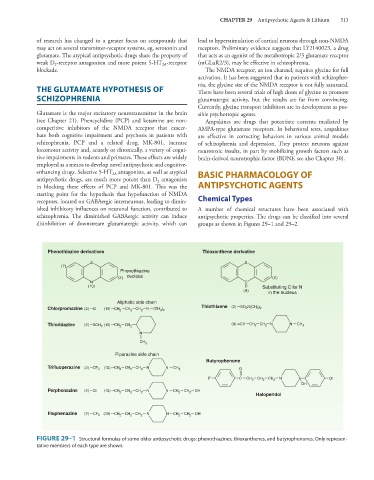Page 527 - Basic _ Clinical Pharmacology ( PDFDrive )
P. 527
CHAPTER 29 Antipsychotic Agents & Lithium 513
of research has changed to a greater focus on compounds that lead to hyperstimulation of cortical neurons through non-NMDA
may act on several transmitter-receptor systems, eg, serotonin and receptors. Preliminary evidence suggests that LY2140023, a drug
glutamate. The atypical antipsychotic drugs share the property of that acts as an agonist of the metabotropic 2/3 glutamate receptor
weak D -receptor antagonism and more potent 5-HT -receptor (mGLuR2/3), may be effective in schizophrenia.
2
2A
blockade. The NMDA receptor, an ion channel, requires glycine for full
activation. It has been suggested that in patients with schizophre-
nia, the glycine site of the NMDA receptor is not fully saturated.
THE GLUTAMATE HYPOTHESIS OF There have been several trials of high doses of glycine to promote
SCHIZOPHRENIA glutamatergic activity, but the results are far from convincing.
Currently, glycine transport inhibitors are in development as pos-
Glutamate is the major excitatory neurotransmitter in the brain sible psychotropic agents.
(see Chapter 21). Phencyclidine (PCP) and ketamine are non- Ampakines are drugs that potentiate currents mediated by
competitive inhibitors of the NMDA receptor that exacer- AMPA-type glutamate receptors. In behavioral tests, ampakines
bate both cognitive impairment and psychosis in patients with are effective in correcting behaviors in various animal models
schizophrenia. PCP and a related drug, MK-801, increase of schizophrenia and depression. They protect neurons against
locomotor activity and, acutely or chronically, a variety of cogni- neurotoxic insults, in part by mobilizing growth factors such as
tive impairments in rodents and primates. These effects are widely brain-derived neurotrophic factor (BDNF, see also Chapter 30).
employed as a means to develop novel antipsychotic and cognitive-
enhancing drugs. Selective 5-HT antagonists, as well as atypical BASIC PHARMACOLOGY OF
2A
antipsychotic drugs, are much more potent than D antagonists
2
in blocking these effects of PCP and MK-801. This was the ANTIPSYCHOTIC AGENTS
starting point for the hypothesis that hypofunction of NMDA Chemical Types
receptors, located on GABAergic interneurons, leading to dimin-
ished inhibitory influences on neuronal function, contributed to A number of chemical structures have been associated with
schizophrenia. The diminished GABAergic activity can induce antipsychotic properties. The drugs can be classified into several
disinhibition of downstream glutamatergic activity, which can groups as shown in Figures 29–1 and 29–2.
Phenothiazine derivatives Thioxanthene derivative
S S
(7)
Phenothiazine
(2) nucleus (2)
N C
(10) Substituting C for N
(9)
in the nucleus
Aliphatic side chain
Thiothixene (2)
Chlorpromazine (2) Cl (10) CH 2 CH 2 CH 2 N (CH ) SO 2 N(CH 3 ) 2
3 2
Thioridazine (2) SCH 3 (10) CH 2 CH 2 (9) CH CH 2 CH 2 N N CH 3
N
CH 3
Piperazine side chain
Butyrophenone
Trifluoperazine (2) CF 3 (10) CH 2 CH 2 CH 2 N N CH 3 O
F C CH 2 CH 2 CH 2 N Cl
OH
Perphenazine (2) CI (10) CH 2 CH 2 CH 2 N N CH 2 CH 2 OH
Haloperidol
Fluphenazine (2) CF 3 (10) CH 2 CH 2 CH 2 N N CH 2 CH 2 OH
FIGURE 29–1 Structural formulas of some older antipsychotic drugs: phenothiazines, thioxanthenes, and butyrophenones. Only represen-
tative members of each type are shown.

